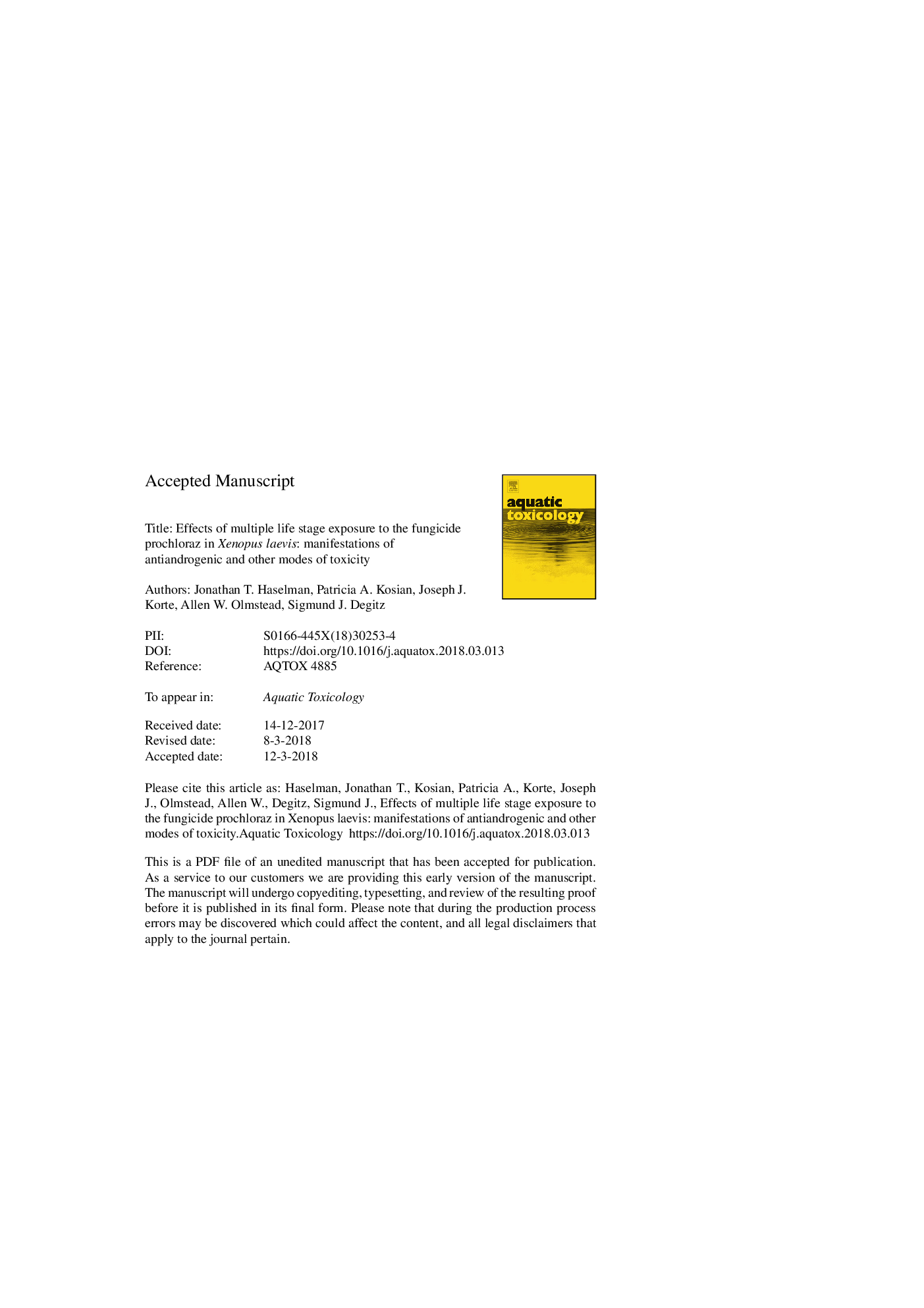| کد مقاله | کد نشریه | سال انتشار | مقاله انگلیسی | نسخه تمام متن |
|---|---|---|---|---|
| 8883757 | 1625906 | 2018 | 38 صفحه PDF | دانلود رایگان |
عنوان انگلیسی مقاله ISI
Effects of multiple life stage exposure to the fungicide prochloraz in Xenopus laevis: Manifestations of antiandrogenic and other modes of toxicity
دانلود مقاله + سفارش ترجمه
دانلود مقاله ISI انگلیسی
رایگان برای ایرانیان
کلمات کلیدی
موضوعات مرتبط
علوم زیستی و بیوفناوری
علوم کشاورزی و بیولوژیک
علوم آبزیان
پیش نمایش صفحه اول مقاله

چکیده انگلیسی
The Larval Amphibian Growth and Development Assay (LAGDA) is an internationally harmonized testing guideline for evaluating effects of chronic chemical exposure in amphibians. In order to evaluate the effects of chronic exposure to an antiandrogenic chemical in an amphibian model, prochloraz was tested using a variation of the LAGDA design. Exposure was initiated with <1d post-fertilization embryos at nominal concentrations of 0, 6.7, 20, 60 and 180â¯Î¼g/L (0, 18, 53, 159, 478â¯nM) and continued in flow-through conditions until two months following the median time that controls completed metamorphosis. Growth, developmental rate, circulating thyroid hormone and thyroid gland histopathology were evaluated in a subsample at completion of metamorphosis. There were no effects on growth or development at this stage, but circulating thyroid hormone was elevated in the 20, 60 and 180â¯Î¼g/L treatments and minimal to mild thyroid follicular cell hypertrophy was observed histologically in the 180â¯Î¼g/L treatment. Growth, overt toxicity, and reproductive development were evaluated at test termination. There were no effects on growth in either gender, but livers and kidneys exhibited treatment-related pathologies consistent with organ toxicity related to metabolism and presumably impaired excretion of prochloraz metabolites. Histological assessments of female ovaries resulted in minimal pathologies only in the 180â¯Î¼g/L treatment while male testes exhibited numerous treatment-related pathologies that are consistent with previously reported antiandrogenic effects of prochloraz in other species. The most severe testis pathologies occurred in the 180â¯Î¼g/L treatment; however, incidences of treatment-related pathologies occurred in all prochloraz treatments. Müllerian duct regression in males was inhibited by prochloraz exposure while Müllerian duct maturation in females was accelerated, characteristic of a feminizing effect. Gene expression levels of potential biomarkers of testis function were also measured. Relative abundance of cyp17a1 transcripts was generally unaffected by prochloraz exposure whereas the Insl3 orthologue, rflcii, was elevated by 3 and >5-fold in the 60 and 180â¯Î¼g/L treatments, respectively, indicating impaired Leydig cell maturation and testosterone signaling. Overall, prochloraz exposure caused effects characteristic of an antiandrogenic mode of action, which is consistent with previously reported results in other species and supports the utility of the LAGDA design for chemical testing.
ناشر
Database: Elsevier - ScienceDirect (ساینس دایرکت)
Journal: Aquatic Toxicology - Volume 199, June 2018, Pages 240-251
Journal: Aquatic Toxicology - Volume 199, June 2018, Pages 240-251
نویسندگان
Jonathan T. Haselman, Patricia A. Kosian, Joseph J. Korte, Allen W. Olmstead, Sigmund J. Degitz,